
Summary
A guide to planning, researching, and creating your IB Film Text Analysis
2022-23 Films (Pick ONLY One for your TA)
Past Sample Student Work
Pan’s Labyrinth
Guidance for Your Work
“The TA is an exam. Failure to turn in the work within the 4 weeks, unless the teacher requests extenuating circumstances directly from the IB, should be considered a fail.” – IB Film
13.5 Hours To Complete
Step 1 – Preparation: Spend 2 Hours
Total Time: 1.5 Hours
Date Complete: 5/28/23
- Thoroughly read the TA requirements in IB Film Guide PDF (including rubrics) (15 minutes)
- Review the TA Task Details
- Clear cover page with the Title of the Film & Timecode (5-minute film extract)
- Sans serif 12 point font
- In-text citations
- List of all sources
- The textual analysis (1,750 words maximum) is intended to be a formalist exercise rather than a thesis-driven
essay. - The focus of the work should be on how meaning is conveyed through the use of film elements in
the chosen film text, with consideration of the cultural context of the film and communicated through the
use of relevant and accurate film vocabulary common to the study of film and appropriate for film analysis. - In this task, the examiner is looking for evidence of the extent to which the student is able to demonstrate an
understanding of:- The cultural context of the chosen film text
- The use of film elements to construct meaning in the selected extract, using appropriate film vocabulary
- How the identified film elements in the selected extract relate to the cultural context of the film, to the film text as a whole, and, where appropriate, to other films, as identified by the student
- At the start of the textual analysis, students should clearly state which film elements they are going to
discuss. - The list of all sources used is excluded from the textual analysis word limit
- Read Examples and Scoring Guides (45 minutes)
- Review the Big List of Film Terms (15 minutes)
- Review the Text Analysis Worksheet (PDF) (5 minutes) – Used in Peer Review, too
- Explore the CHS Library: capital.osd.wednet.edu/academics/library (5 minutes)
- Explore The Moving Image Source Research Guide: www.movingimagesource.us (5 minutes)
- The Moving Image Source Research Guide is a gateway to the best online resources related to film, television, and digital media
- Explore Mr. Le Duc’s Film Resources Page (5 minutes)
- Examine the TA Poster 1 (PDF) (5 minutes)
- Examine the TA Poster 2 (PDF) (5 minutes)
Step 2 – Pick a Film, Watch It, and Write Notes: Spend 4.5 Hours
Total Time: 5.5 hours
Date Complete: 6/3/23
The goal of IB Film is to expose students to films from all over the world and to increase their critical and practical understanding of film as a creative art form and reflection of its time period, society, and political and cultural environment. As a result, this class requires the viewing of a wide variety of films. In some cases, these films may carry an R rating, or, in the case of films made before 1968 and some foreign films, will have no rating at all. Please be assured that all the films selected for this course have a high degree of artistic merit and that many have won numerous awards and are considered part of the film canon. However, if you object to any film shown that does carry an “R” rating, you will always have the opportunity to request that an alternative film be assigned, and/or be excused from class and not view the film.
- Watch the trailers and pick ONE of these films (10 minutes)
- Review Drew’s TA Guide Sheet (he scored very high!) (10 minutes)
- First Viewing: Watch the film and record your reactions (2 hours)
- Although the story follows a very linear and basic trajectory, the visual elements give this movie a feel that is almost like a time capsule of the time. In the bustling nightlife of Japan, neon signs and technology that we still don’t have in the West today, shine illuminating the streets, all while cars from the early 2000s pack the roads and Plinko machines line the walls of local stores. The soundtrack, when present, is almost psychedelic and/or old fashion. When there are lyrics, it talks about the characters’ lives and how they are feeling.
- Second Viewing: Notice the cinematography, mise en scene, actor movement, wardrobe, sound (diegetic, non-diegetic, music, etc.) choices (2 hours)
- Review the Big List of Film Terms for cinematic elements, mise en scene (what’s represented on screen), and sound
- Write notes (below in this post)
The movie has extensive use of lighting with the characters to show their environment.
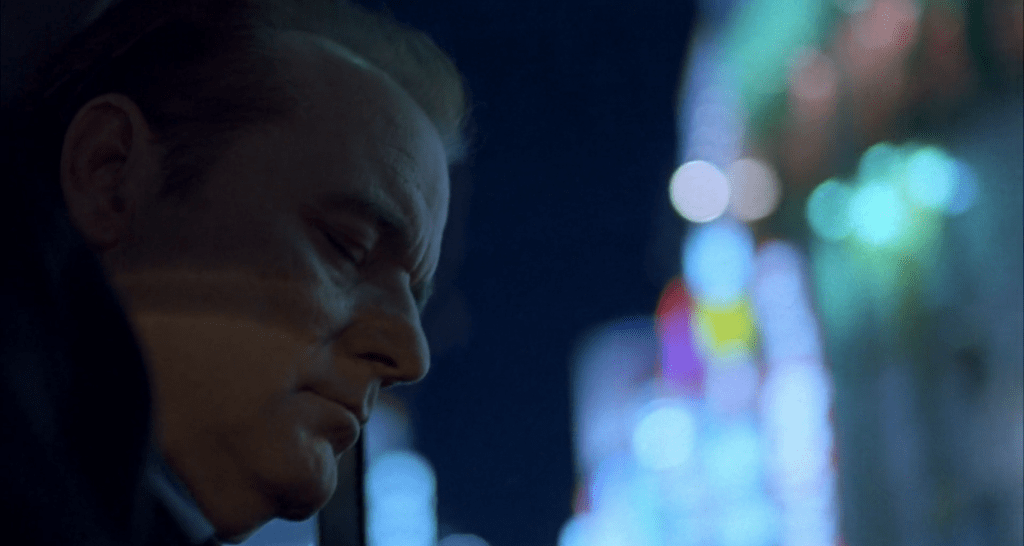
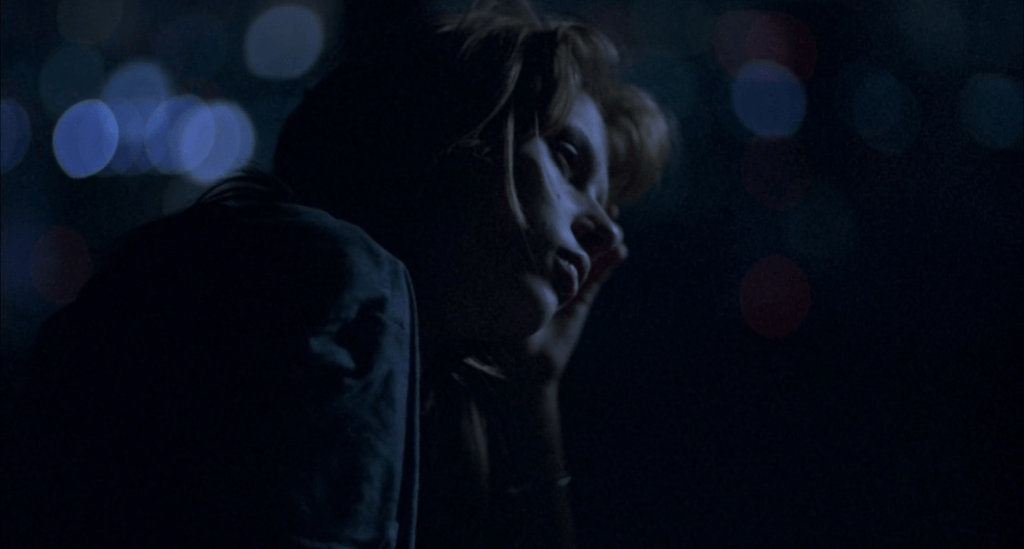
In the film, blue is often shown with the main characters when alone. Blue is a color that is known for being isolating in film and one of the most isolating situations you can be in is being in a country that doesn’t speak the same language as you all while being alone. In the first screenshot above, blue is pouring onto Bob Harris by the extremely colorful surroundings. This is one of the first shots of the film and he is alone in the back seat of a car while bright signs he can’t read flash all around him.
Isolation plays a big part in the film and this is evident through the many shots where the characters look out of place.
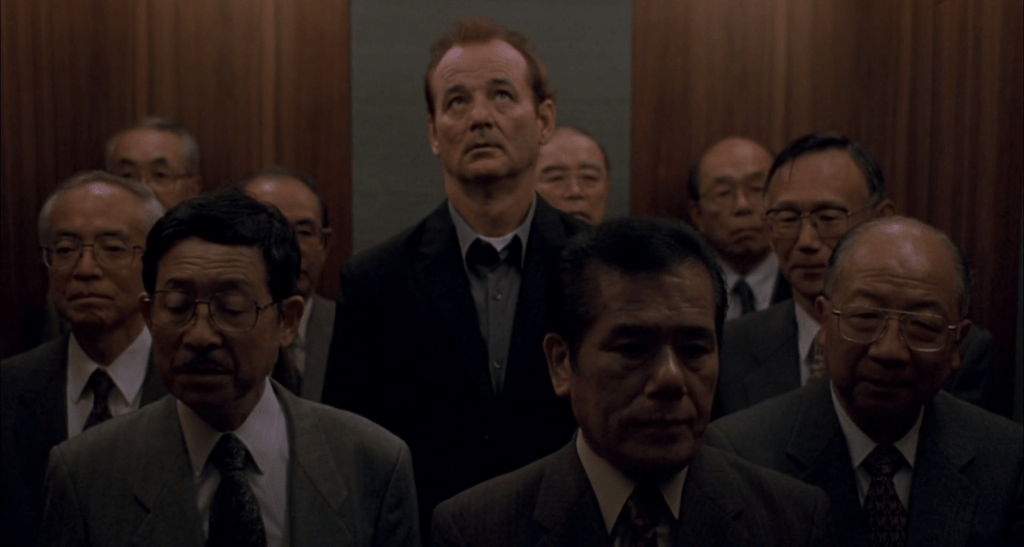
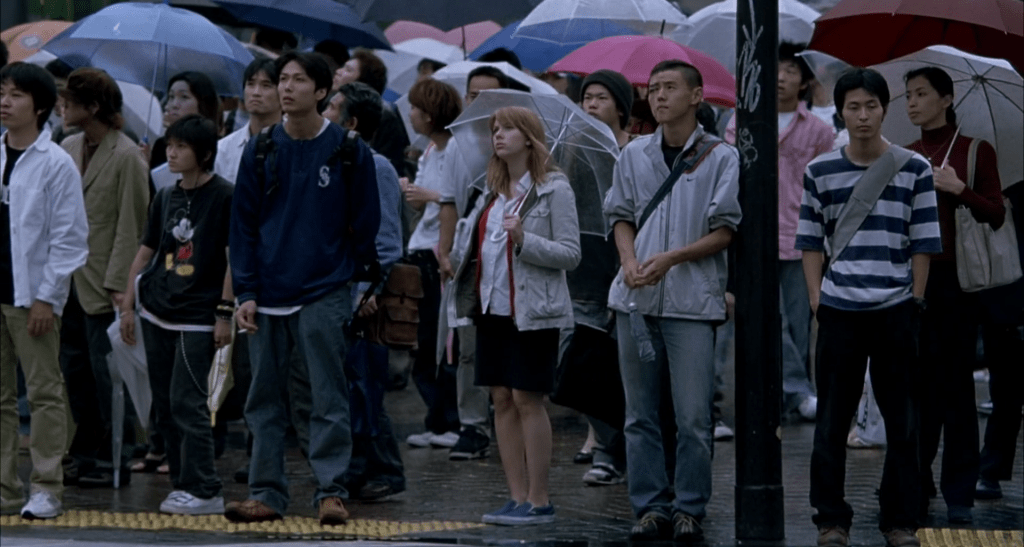
In these scenes where the characters are portrayed as out of place in the city, the people around them have a very drained color palette that makes them feel boring and almost like background props to fill the scene. In the third still, you can see how the people surrounding Harris are all shorter men with grey suit and tie while Harris has no tie and a black suit. To make the audience look at him even more, he is taller than everyone else, the only one centered in the shot, staged in the midground making him even more centered, he is one of the only ones fully lit by the light, he is in full focus, and he is even standing in the grey segment of the wall contrasting the wooden walls that everyone else is around.
Repeating shots styles is also common between the two characters.
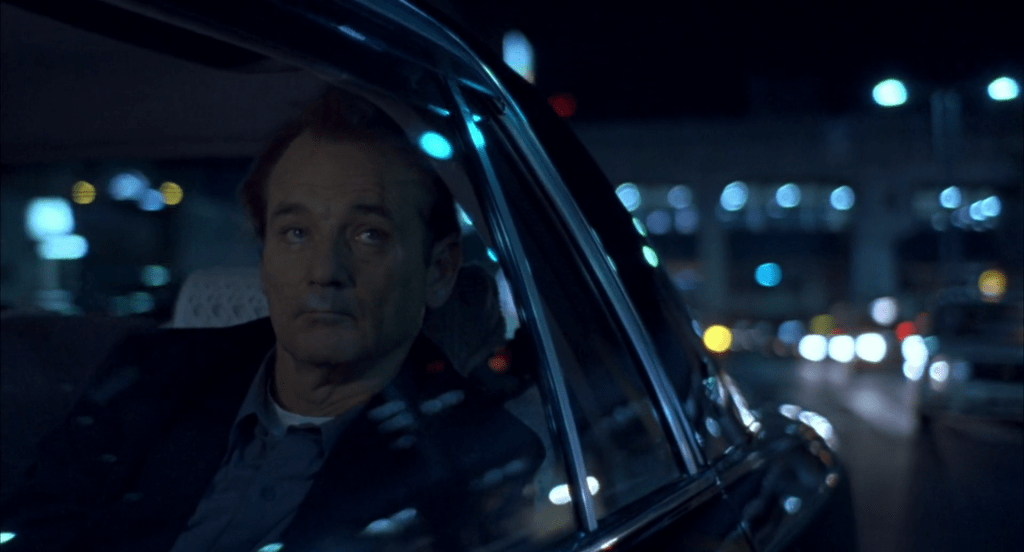
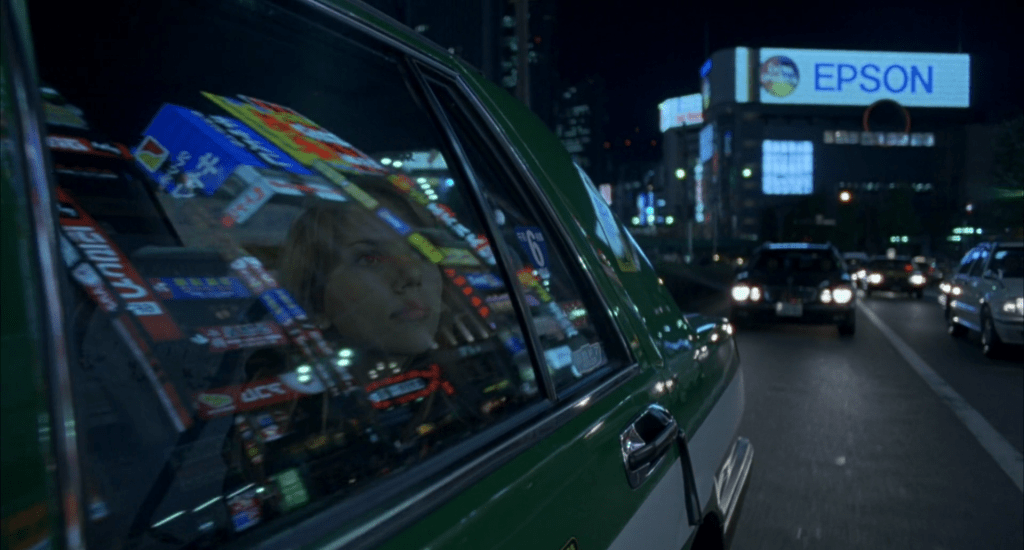
Repeating shots can show how the characters are becoming closer and more alike throughout the story.
In the film, the composition is very used a lot to make the audience feel a certain way.
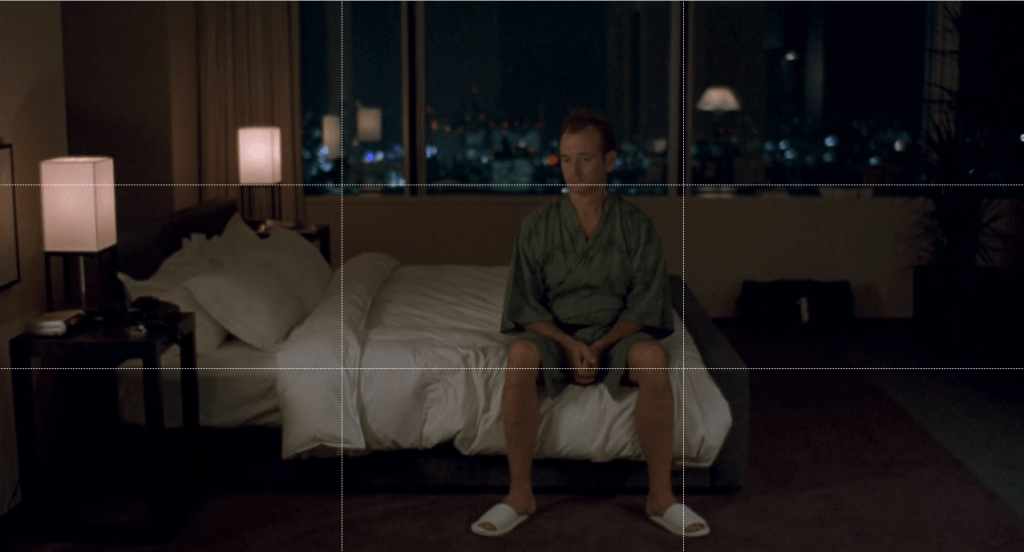
(Rule of thirds grid added by me)
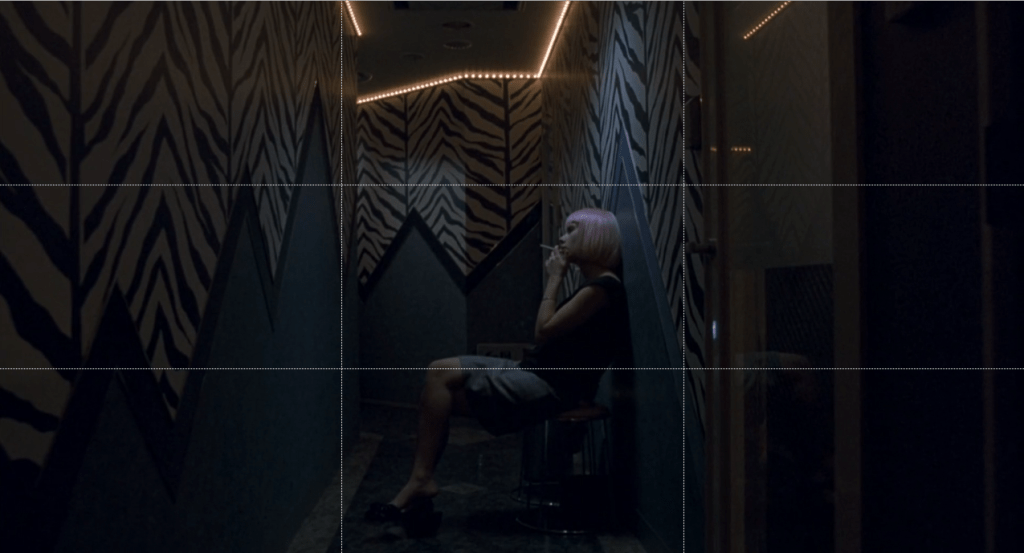
(Rule of thirds grid added by me)
The film uses shots like these to show that there is something wrong with the characters at that moment. Using the rule of thirds we can see that the characters are not on any of the common focus points but also not fully centered. This creates an unsettling vibe to the shot. In Fig. 8, this shot is then immediately contrasted with the next shot which is completely symmetrical.
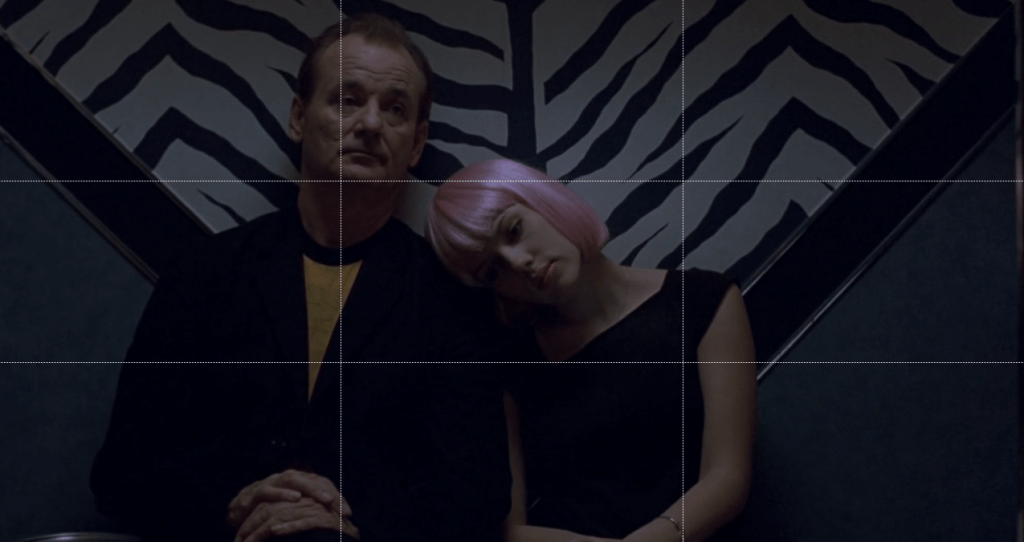
Each character on their own focus points and the wall decoration is perfectly symmetrical separating the two until Charlotte leans her head breaking the line separating them and basically bridging the gap between the two.
Step 3 – Choose Your Extract, Watch It, Write Notes, and Research: 2.5 hours
Total Time:
Date Complete:
- Open your TA Bibliography Google Doc (In Your IB Google Drive Folder – Mr. Le Duc created)
- You will add your MLA sources as you research
- Choose your 5-minute extract (scene)
- Re-watch this scene numerous times and write notes in the Task Analysis Guide (below) (15 minutes)
- Narrative (Le Duc will fix this link)
- Camerawork: Angles, and Movements
- Composition
- Lens: Depth of Field (Le Duc will fix this link)
- Mise-en-scene
- Blocking / Position of characters
- Acting/body language
- Acting style / method
- Lighting / Cinema Lighting
- Color scheme
- Set/location/props
- Set design
- Costume, hair, makeup, class, gender fabric, color
- Sound Design
- Soundtrack/Score
- Editing
- Research to support your notes (1 hour)
- Cultural context Evidence: Textual analysis and sources
- Answer these questions:
- To what extent do you demonstrate an understanding of the cultural context of the film text?
- To what extent do you support your understanding of the cultural context with research from appropriate and relevant sources?
- Answer these questions:
- Add to your notes in the Task Analysis Guide
- Cultural context Evidence: Textual analysis and sources
- Re-watch your scene numerous times and add to your notes (15 minutes)
- Research to support your notes (1 hour)
- Re-read Criterion B Film Elements Rubric
- Evidence: Textual analysis and sources
- To what extent do you evaluate how the extract makes use of film elements to convey meaning in the chosen film?
- To what extent do you support your observations with the appropriate use of relevant film vocabulary?
- Evidence: Textual analysis and sources
- Write notes (below in this post)
- Re-read Criterion B Film Elements Rubric
Step 4 – Compose A Rough Draft within the Text Analysis Guide below: 2 hours
Total Time:
Due June 9 before class (Mr. Le Duc will look over your progress in class)
Date Complete:
- Watch Mr. Le Duc’s Convert a Table into Text with Editpad.org tutorial and do the following: (5 minutes)
- Copy and paste the two columns of your Text Analysis Guide notes (below) into editpad.org
- This will convert your two-column table layout into a regular text document
- Copy and paste from editpad.org into your Google Docs TA Paper Template
- Copy and paste the two columns of your Text Analysis Guide notes (below) into editpad.org
- Thoroughly re-read and examine your work with the Text Analysis Rubric (PDF) (10 minutes)
- Compose your rough draft (1.75 hours)
- Weave in your research the following
- WHAT: Your observation about a film element in the 5-minute scene
- WHY: Relate the film element to the shot or scene’s emotional or narrative importance
- HOW: Explain how the film element works in the context of this scene
- SO WHAT: Justify it with the cultural context, as needed
Text Analysis Guide (For your 5 Minute Scene)
| TASK COMPONENTS (INQUIRY) | NOTESWRITE NOTES IN THIS COLUMN |
| The extract may be up to five minutes in length and must be a single, continuous sequence of the film | |
| Time of 5-minute clip | PLACE 5-MINUTE TIME INTERVAL HERE… |
| PART 1 – The film, your scene, why it is of interest, and how your scene relates to the whole film. | Lost In Translation, 44:01-49:01, this is a portion of the film that really stood out to me during my first viewing because it completely changes how we see the main characters but also the world around them. This segment stands out because of the psychedelic music that takes control of a film that has had no other montages or any situations where the film’s music is the focus. This is also a pivotal point in the story where the 2 main characters feel like they are super close friends and even a small amount of love. The characters are no longer strangers that just so happened to stay at the same hotel. |
| Brief Summary of ExpositionWriter, Director, Producer, studio, year released Main characters, conflict, identify the genre. Identify the aspect ratio. | Exposition: The 2 main characters (Americans) find themselves in Japan, they are lost, and they don’t know the language, culture, etc. Writer: Sofia Coppola Director: Sofia Coppola Producers: Ross Katz and Sofia Coppola Studio: American Zoetrope Elemental Films Release Year: 2003 Main Characters: Bill Murray as Bob Harris and Scarlett Johansson as Charlotte Conflict: The conflict is a bit different between the 2 main characters, but the general idea is that they are both not only lost in Japan but in their own lives as well. Genre: Romantic Comedy-Drama Aspect Ratio: 1.85:1 |
| Context of Extract in Film – briefly describe the scene. At what times does your scene occur, how it begins, and how it ends. Do not describe it further. The judges have seen the movie. | Extract: 44:01-49:01 (5 minutes) The scene begins a new setting for the film, the nightlife in Tokyo. Although the movie has explored this a small amount, only while in a car or in the hotel. Never had the characters, until this point, gone out and experienced the nightlife culture. The scene starts with the 2 characters meeting with some of Charolette’s Japanese friends at a local party. This small montage of the party begins with psychedelic imagery and music providing the uncertainty of the night for Bob Harris. Bob quickly learns to love and take advantage of the night though and has lots of fun. The end of the segment shows Bob, Charlotte, and a few Japanese friends at karaoke. |
| The Rationale for Selection – relation to the entire movie, Why is it interesting and why does this scene best illustrate the themes of the whole movie? | This segment is very important to the entire movie because it shows both the characters what they want. They are trying to make the most of their life and a good place to start is by having fun. This is also a very important scene for the characters’ progression. Bob goes into the night not knowing what will happen and this makes Bob quite cautious at first. This is because he is in this foreign country where he has already learned how different the culture is from his own American culture. He learns to warm up to the people in Japan though and realizes that he may not be as lost as he thought because everyone around him is still human after all. |
| PART 2 – Remember to integrate the Director’s intent with each of the following areas in this section | |
| Narrative | |
| Script – Not just dialogue but in terms of being the spine of the story Explain how this scene advances the plot. How do the events of this scene clarify/complicate matters? How does this scene affect/cause future events? What new information is revealed or suggested about a character? Is there anything deliberately withheld? Is anything unusual in the dialogue? Word choice? Delivery? Accents? Repetition? | Individuals: Each character is chasing and reaches what they want in this segment. They want to make the most of their lives and they achieve this by having fun with the nightlife in Tokyo. Bob: He escapes the worries of his job and finally has fun. He discovers that he isn’t as lost as he might have thought he was in Japan. He meets many new people and can finally talk to other people about things that are not regarding business. The city is no longer the boss of him and he feels a sense of freedom. Charlotte: Escaping the hotel and having a great night with her friends and solidifying her friendship with Bob. Still fresh out of college, she still wants to live her prime days to the fullest. Both: This marks the point in the film where they both feel the most comfortable and happiest when around each other. They find the everyday life of sitting in their hotel, doing mundane work for money, and exploring Japan for something they just can’t find, unenjoyable. But when together, they are familiar with each other because their language and culture are the same. This is the point in the film where they are now officially full friends and no longer strangers. This is also when ill-fated love starts to form. The characters know it will never work but humans still have feelings anyways. |
| Cinema Photography | |
| a) Camerawork – describe shots in specific terms Shot size: ELS, LS (stage), full shot, MS, CU, ECU. Camera angles: bird’s eye, high angle, eye level, low angle or Dutch (oblique), camera movement: pan, tilt, dolly or tracking, handheld, Steadycam, or moving crane. Invisible V conspicuous. Are tracking shots motivated by character movement? | Almost every single shot uses the handheld feel. The director really wanted to get across the feeling that the audience was there with them running through the streets, being at a bar, and the chaos of it all. There are handheld shots where the camera is literally running behind and with the characters through the streets, Plinko parlors, etc. Some shots feel so unstable, it feels like a POV or a home film made with a handycam. In the party, with people everywhere, all the shots are very close up making a claustrophobic feel, while outside shots are very wide and have the characters in the middle of the screen from across the street. The camera remains at eye level. |
| b) CompositionOpen/closed composition, aspect ratio, rule of thirds, Kubrick single-point perspective. | Although unstable, the composition is very closed with characters always on screen. In the party rule of thirds is in almost every shot. A character is always on one of the two verticle lines. While outside and running around, however, the characters are often in the middle of the screen. |
| c) Depth of FieldConsider foreground, mid, ground, and background. Deep focus is associated with wide-angle lenses. Could be flat. Narrow ranges of focus may be the result of telephoto lenses. | During the party, the depth of field is inconsistent, to say the least. Often fast focus pulls, lack of focus pulls, lots of shallow focus, and blurriness on the topic of the shot. These effects come together to make chaos that is just enough to convey the message all while not overdoing it. During the street scenes, there is a fairly deep focus while keeping a small amount of the shallow focus from the party. |
| Mise-en-scene – The overall look and feel of a movie | |
| a) Position of characters and objectsIdentify the dominant, does movement guide our focus, character proxemics patterns (intimate, personal, social, and public distances). How does the director add meaning to these choices? Is one character encroaching on another’s space? Watch for space being used to portray relationships/changes in relationships. Watch for windows, doors, and parallel lines that frame people or objects. Entrapment. Look for actor placement. Front – actor facing camera, greatest intimacy. One-Quarter Turn – very popular. Profile – character lost in the moment, a bit more distant than the previous two. Three-Quarters Turn – useful to convey anti, socialness, Back of Head, most anonymous shot. Creates a mystery or feeling of alienation. | Party: Near Bob, all the characters are very close to the camera and lots of characters flood the setting making a very claustrophobic environment for the audience. When shots of Charolette appear, the camera is always far away, portraying that Bob is looking at her from the other side of the party. When shots that just involve Bob and his actions, the camera is very close showing that the main focus is on Bob in the scene. Streets: The characters are often far from the camera, sometimes even down the street. With this large amount of space on the screen, on paper, it may seem hard to keep track of the main characters, but on the streets, there are very limited people/ background actors. Keeping the actors in the middle of the screen helps with the tracking problem. When the camera is close to the characters they are typically shown from behind. |
| b) LightingLow or high key. How does the director use light to focus our attention? The Key light, fill light, and backlighting. What is the source of lighting in the context of the scene? | Party: The lighting is very low and when characters are in focus they have only one or two primary light sources lighting them, but staying realistic to the rest of the low-lit environment. When the characters are in focus and having a conversation the primary lighting comes from below them pointing up. Throughout the rest of the montage, there are shots of a dark area that is completely lit by a projector playing videos of fireworks. And many people in this area are just silhouetted and completely backlit. This provides even more to the party-like style that is conveyed through lighting. Streets: In the street scenes, the streets are completely lit by neon signs, street lights, and cars making a totally different feeling from the very dark lighting in the party. With lights everywhere, the dark night becomes light again. |
| c) Color scheme How does the director use color and what is the director’s intent for doing so? Look for color symbolism or color associated with characters. Color to suggest a mood. Color as foreshadowing. Contrasting colors ( the monolith v white room) | Party: It is soft-lit with lots of warm colors like yellow and orange creating a juxtaposition between the chaos of the party and the warm calming colors. Streets: The extreme blues create a huge contrast between the previous party scene. With lots of cool colors and flashes of random colors like deep reds in the background. |
| d) Set/location/propsSet design. Studio or on, location, describe props, scenery, what was the Director ́s intent for using them? How dense is visual information? Stark, moderate, or highly detailed? | Party: The location of the club in the scene brings the environment to life making it feel like a super realistic party. The props in the scene further boosting the feel of the realism of the party. Drinks, bottles, and an airsoft gun (not a super uncommon thing to see in Japan because of the strict gun laws). Streets: The location hosting the club in a lively ally way shows off more of Japan’s nightlife culture. A Plinko parlor is also a very common thing in Japan where people gamble. The characters run through the parlor without a care showing that they have conquered their fear of the city. The roads are filled with cars and cabs lining the roads showing how alive the night still is. |
| e) Costume, hair, make up Period, class, gender (emphasize or diminish), age-appropriate, silhouette (close-fitting or baggy), fabric (plain, sheer, rough, delicate), accessories. Color is very important in relation to character. | Party: Bob is overdressed for the occasion showing that he didn’t know what would be happening that night. Everyone around him wore T-shirts and polos, while he has a full suit with a T-shirt underneath. Streets: Bob still overdressed while running around the city with Charlotte who was prepared. Karaoke: A drastic change in appearance for Charlotte occurred when she has a pink wig on at Karaoke. Bob throughout the night takes off his suit and just keeps the T-shirt. |
| f) Acting/body languageActing style, body language, blocking, period, or contemporary. Individualized (Joker), Stylization. Look for subtext (the character says one thing but means something else). Consider typecasting as a shortcut to characterization. | Bob at the beginning of the segment is cautious and restricted when talking to the Japanese people, but once he gets a few drinks and the night goes on, he becomes much more out there, energetic, but a hint of sloppiness because of the drinking. |
| Sound – watch scene w/o pictureLive sound, sound effects, and music. Sound can be diegetic, meaning characters would hear it, or non, diegetic, meaning that characters would not hear it, such as narration or music over the credits. Explore the relationship between diegetic and non, diegetic sound when appropriate. | A lot of the time, the segment is drowned out with sound and not a lot of moments of calm. Every moment has dietetic sounds. Sounds of cars, people talking, music that is playing at the locations, bottles, and other street noises. |
| Music Is the music telling you what to feel? Music can be used as a counterpoint to the action. | Throughout the entire 5 minute segment, a song is almost always playing. There is a total of 7 different songs that play being both diegetic and non-diegetic. There is a song throughout the party scene that lets the chaos unravel and then is abruptly cut and transitioned into a dialogue. There is music played at the 2nd party of the night, both diegetic and non-diegetic. At karaoke, the songs the characters sing have to do with how they are feeling in their lives. |
| Editing Ellipsis (time compression) and cross-cutting, fades, dissolves (fades between scenes), wipes, matching cuts, straight cuts, dialogue overlap, and sound bridges. Consider how long each shot lasts. | During the montage of the party, there are lots of fast cuts in the editing. After a dialogue between Bob and a few people, the montage continues, and the same audio is used over the course of multiple cuts. |
| Part 3: Analyzing the Film as a Product | |
| Sociocultural Context In what way was this movie a product of its time? What does the audience learn about the culture or historical context of the film? | This movie takes a look at the clash of diverse cultures, heightened by language barriers that pose obstacles to outsiders in unfamiliar surroundings. It sheds light on a pivotal moment, when Japan seized center stage in the global cultural landscape, enjoying considerable popularity and influencing pop culture globally. In my initial notes, I talk about how I feel like this film is a time capsule of when it was made. “the visual elements give this movie a feel that is almost like a time capsule of the time. In the bustling nightlife of Japan, neon signs and technology that we still don’t have in the West today, shine illuminating the streets, all while cars from the 90s and early 2000s pack the roads”. During this time in America, it was very uncertain and anxious because of the recent 9/11 attacks. This can be interpreted in the movie through the characters’ uncertainties about their own lives. |
| Target AudienceTeens/adults or male/female age group, college education art crowd, liberal, conservative, Christian | Young adults and adults of any gender. |
| Generic Expectationshttp://www.filmsite.org/filmgenres.html Also research http://tvtropes.org/pmwiki/pmwiki.php/Main/Tropes | I went into the movie thinking it was going to be a semi-boring love story where the characters don’t have any progression in their own lives. |
| ThemesMan V Man, or one of the others, is this film an allegory? | Man Vs Finding Yourself/Your Purpose. Live your life to its fullest. |
| Motifs/SymbolsWhat specific devices support your definition of the theme? Look for recurring elements. | The main characters talk about how they are lost literally and existentially. |
| Film CriticismBoth contemporary and current. Use brief quotes from two different sources. Record the details: reviewers’ names and publication names/dates | “Like half of the film’s runtime is Bill Murray making fun of the fact that the Japanese people don’t have perfect English pronunciation while completely ignoring the fact that they speak two languages while he speaks one. The jokes get way more racist and uncomfortable than that” January 14th, 2020 by Penny (Letterboxd). “Lost In Translation is a film that I had never seen before, and it’s one experience that has been greatly lacking in my life. The emotion and beauty in this film is staggering, even monumental. The characters feel real, and the setting reflects their feelings and thoughts. Simply put, Lost In Translation is an astonishing movie that I completely fell in love with” March 25th, 2014 by SilentDawn (Letterboxd) |
| TASK COMPONENTS (ACTION) | |
| Compose Paper | |
| Part 4: Sources | |
| Source 1 | https://www.imdb.com/title/tt0335266/ |
| Source 2 | https://letterboxd.com/greenpatina/film/lost-in-translation/ |
| Source 3 | https://letterboxd.com/silentdawn/film/lost-in-translation/ |
| Source 4 | https://en.wikipedia.org/wiki/Lost_in_Translation_(film)#Critical_response |
| Source 5 | |
| Source 6 | |
| Source 7 | |
| Source 8 | |
| Source 9 | |
| Source 10 | |
| TASK COMPONENTS (REFLECTION) | |
| Revision 1 | Proofreader: |
| Revision 2 | Proofreader: |
| Revision 3 | Mr. Le Duc |
Step 5 – Get Draft Peer Reviewed: 30 Minutes
Total Time:
Due June 12 before class (we will be peer reviewing in class)
Date Complete:
- Get it peer-reviewed with the TA Worksheet (PDF) (30 minutes)
- Peer Reviewer: Look for evidence of each section of the document
- Look for WHAT, WHY, and HOW for each statement in the paper
- There should be at least one WHY or HOW or every WHAT statement
- Look for cited research to support statements, where it makes sense
- Write comments to help the author
- Add them as “Add Comments” on the side, so you do not add to the word count of the document
Step 6 – Revise: 1 Hour
Total Time:
Date Complete:
- Revise your draft (1 hour)
Step 7 – Get Feedback from Mr. Le Duc and Revise: 30 Minutes
Total Time:
Due June 13 before class (Mr. Le Duc will have feedback by June 16)
Date Complete:
- Get feedback from Mr. Le Duc
- Make final revisions and check format (30 Minutes)
Step 8 – Finalize Paper: 15 Minutes
Total Time:
Date Complete:
- Clear Title of the Film & Timecode (5-minute film extract)
- Sans serif 12 point font
- In-text citations
- Less than 1,750 words maximum
Step 9 – Finalize Bibliography and Check Format: 15 Minutes
Total Time:
Date Complete:
- Update your TA Bibliography Google Doc (In Your IB Google Drive Folder)
- Finish and check the format of your MLA sources as you research
Step 10 – Upload to Turnitin.com: 10 Minutes
Total Time:
Date Complete:
- Upload your TA paper (from Your IB Google Drive Folder)
- Upload your TA Bibliography Google Doc (from Your IB Google Drive Folder)
External Assessment Criteria SL and HL
Peer Review Checklist
- Use the TA Worksheet (PDF) for review of core elements for the peer review
- Use the TA Marksheet (PDF) for the inclusion of all needed elements in peer review